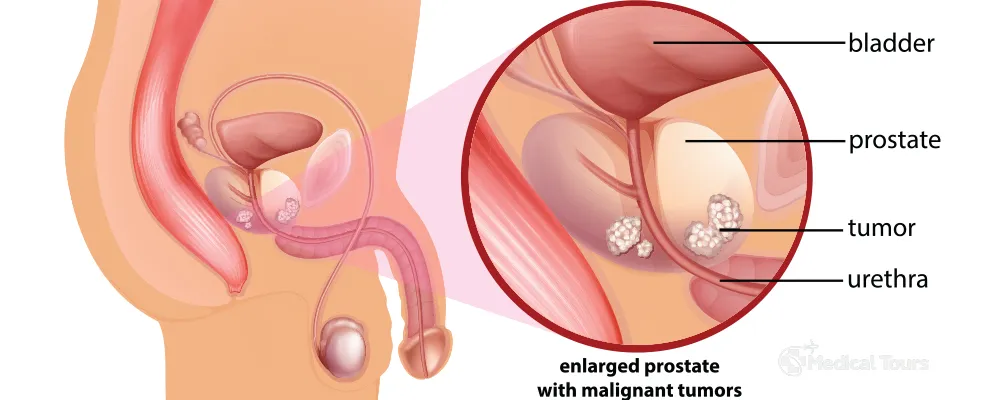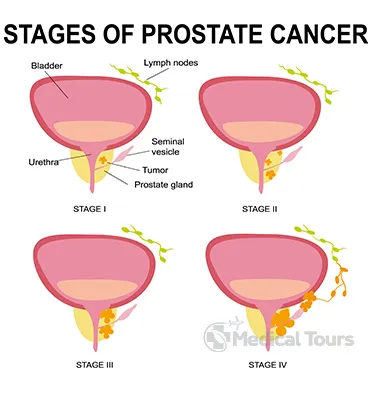Prostate cancer treatment costs in India vary depending on the condition of the patient and the kind of treatment being suggested. The prostate cancer treatment costs in India are listed below to help you compare prostate cancer treatment options.
| S.No. | Prostate Cancer Treatment | Price in ($) | Price in (₹) |
|---|---|---|---|
| 1. | Chemotherapy (per cycle) | USD 300 to USD 2000 | INR 22,200 to INR 148,500 |
| 2. | Open Radical Prostatectomy | USD 3500 | INR 260,000 |
| 3. | Robotic Radical Prostatectomy | USD 6500 | INR 482,000 |
| 4. | Brachytherapy (per cycle) | USD 1100 | INR 81,600 |
| 5. | External radiation (per cycle) | USD 3000 | INR 222,000 |
| 6. | Cyberknife | USD 6000 | INR 445,000 |
| 7. | Laser surgery | USD 5000 | INR 371,000 |
| 8. | HIFU | USD 4000 | INR 297,000 |
Prostate cancer is most common type of cancer in men. This cancer is more widely known as the disease that causes pain in men at the time of urination, difficulty in urinating, dribbling after urination, frequency of urination and weak urine stream. Men over the age of 50 are at a higher risk of developing prostate cancer. It is important to understand this disease and how it affects the body and how you can prevent it.
Prostate cancer treatment in India includes a number of therapies, like surgery (prostatectomy), radiation therapy, cryosurgery, and hormone therapy. Prostatectomy is a simple surgical procedure to remove all or part of the prostate gland as a treatment for prostate cancer. It involves removing the cancerous and benign portions of the prostate gland, which helps in curing this disease forever without affecting sexual function.
Prostate cancer is a type of cancer that begins in the prostate gland. It occurs when the cells lining the prostate gland start to divide and grow uncontrollably, forming a mass known as a tumor. Prostate cancer typically develops slowly and therefore, it can be difficult to identify the early signs of this disease so it should not be ignored.
Small Cell Carcinoma: Early diagnosis is difficult in small cell carcinoma because it is considered as the rare type of prostate cancer. This cancer develops in specialized cells inside the prostate, and it first begins as a small, solid tumor. Small cell carcinoma does not increase prostate-specific antigen levels (PSA).
Adenocarcinoma:Adenocarcinoma is the most common type of prostate cancer. This type of prostate cancer can spread to different areas (such as bones, lymph nodes or other organs) beyond the prostate. It grows slowly, making it easier for our doctors to treat.
In men, the prostate is a small gland that is located just below the bladder. The main function of the prostate is to produce seminal fluid which makes up most of the volume in semen. Cancer of the prostate refers to any abnormal cells in that organ. This can be caused by many factors including genetics and diet.
Stage 1: Stage 1 of prostate cancer means that the cancer is found in just one part of your prostate, or it has not spread outside it. In this stage, your body has only a very small amount of cancer. You may have some blood in your semen if you have this stage of prostate cancer.
Stage 2: Stage 2 cancer is not contained within the prostate and may be present in lymph nodes as well. This stage is also marked by large tumors that are located in both lobes of the prostate or by smaller tumors that have spread to multiple locations in one or both lobes.
Stage 3: Stage 3 represents a significant shift in the growth of the disease. At this stage, the cancer cells have spread beyond the prostate gland, and may also have reached adjacent seminal vesicles or lymph nodes.
Stage 4: The fourth, and final, stage of prostate cancer is when the cancer has spread beyond the prostate. The spread may be to bones or other organs, such as the bladder or rectum.
The price of Prostate Cancer Surgery in India is approximately USD 5500. The cost of the prostate cancer surgery varies on the basis of certain factors such as the number days you spend in India, the type and duration of your treatment and services provided by your doctor.
The prostate is a small gland between the urethra and bladder that is responsible for making up part of the liquid in semen. The fluid makes sure sperm stay healthy and mobile, so they can efficiently fertilize an egg.
PSA is a protein produced by cells of the prostate gland; their degrees help identify prostate ailments. The PSA test can help your doctor determine whether your prostate has become enlarged or if cancer may be present.
Benign Prostatic Hyperplasia is a condition wherein there is an overgrowth of prostate tissue that pushes against the urethra and bladder. It is a noncancerous condition affecting mostly men in their 40s, 50s and 60s.
Prostate cancer is the most common non-skin cancer among men. But there is not any certain way to prevent it, nevertheless with a healthy lifestyle and regular exercise you can reduce the risk of growing it.
Hormone Therapy is a form of treatment given to patients with prostate cancer who have already received radiation therapy and/or chemotherapy. If a patient is not responding well to hormone treatment, there are other types of therapy that can be given, such as external beam radiation therapy or high-dose-rate brachytherapy.
Radiation is the number one treatment for prostate cancer in the world. It is used to destroy or shrink the prostate gland, which can help slow down cancer. Radiation is usually given 5 days a week for 4-8 weeks (about 2 months), depending on how quickly your body absorbs and eliminates the radiation. The longer you receive it and the stronger the dose, the higher your chances of success with this type of therapy. There are also other factors that come into play when determining your overall cure rate.
Prostate cancer is among the most common cancers affecting men. It is treatable when diagnosed in the early stage, but screening is essential in identifying as well as treating prostate cancer.
Gleason score is a method that suggests how likely it is that prostate cancer cells will migrate or disperse. The Gleason score, which is an overall grouping of the cells that make up the tumor, ranges from 2-10, with 10 being the most likely to spread. A low Gleason score indicates that the prostate cancer cells resemble normal prostate glandular tissue and are less likely to spread.
Regular Monitoring of PSA is a reliable indicator for how the treatment is responding towards the cancer. As your immune system recovers and attacks your cancer, there will be a decrease in the PSA levels.
Erectile dysfunction (ED) is the inability to get an erection that is firm enough for sex. It can happen at any age, but it is common in men over 40. There are many reasons why a man might develop ED, including alcoholism and depression, hormonal changes caused by aging, neurological problems, and cardiovascular disease.
Did you know that the symptoms and signs of prostate cancer do not show up until the cancer has spread outside of the prostate gland? Most diagnoses occur when there is a rise in the PSA level, which is an indicator of potentially harmful cells in your body. This rise can happen anywhere from 2– 5 years before any symptoms appear. There are many factors which can affect your PSA level; however, if you have just been diagnosed or if you had surgery for prostate cancer within the last 6 months, ask your doctor to order a repeat PSA test.



